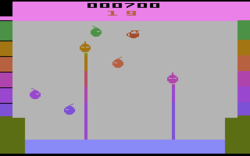Kool-Aid Man (video game)
| Kool-Aid Man | |
|---|---|
 Atari 2600 box art | |
| Developer(s) | Mattel |
| Publisher(s) | Mattel (M Network division[1]) |
| Designer(s) |
Atari 2600: Steve Tatsumi Intellivision: Vladimir Hyrcenko |
| Platform(s) |
Atari 2600 Intellivision |
| Release date(s) |
Atari 2600:
Intellivision:
|
| Genre(s) | Action |
| Mode(s) | Single-player |
Kool-Aid Man is an Atari 2600 video game is centered on the Kool-Aid Man, the long time television mascot of the popular beverage Kool-Aid. A second, unique video game cartridge was also made for the Intellivision.
The game remains as one of the most obvious product placements in video game history, and in a further attempt at marketing the beverage, the game could be obtained for free by mailing in 125 proof of purchase points.
While it was initially available exclusively through mail-order, it was later released through traditional retail outlets.[1]
Gameplay

The setting of the game is a simple pool of water, and the object of the game is to quench the “thirsties”. Thirsties are round creatures that try to drink up all of the water in the pool.
Hitting a thirsty who is not drinking water causes the player to be bumped back and lose time. However, when a thirsty is drinking from the pool (an action indicated by a straw of variable length extending from the thirsty to the pool), he is vulnerable. Hitting him will supposedly use Kool-Aid to quench his thirst, and thus saving the pool. Winning a level usually requires quenching around 30 thirsties, which will take the player to a faster level. The game is lost either by running out of time, or by losing all of the water in the pool.
The Kool-Aid Man can obtain power-ups, giving him temporary invincibility.
References
- 1 2 Bogost, Ian (August 5, 2011). How to Do Things with Videogames (Electronic Mediations). University of Minnesota Press. p. 68. ISBN 978-0-8166-7647-7.
External links
The Atari 2600 version of Kool-Aid Man can be played for free in the browser at the Internet Archive